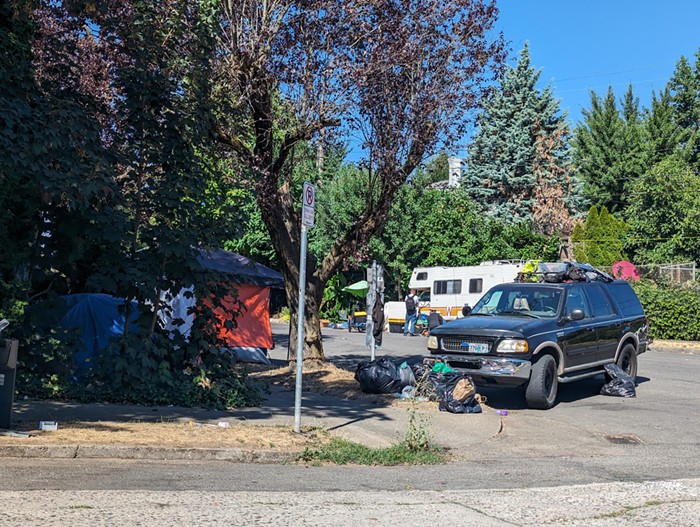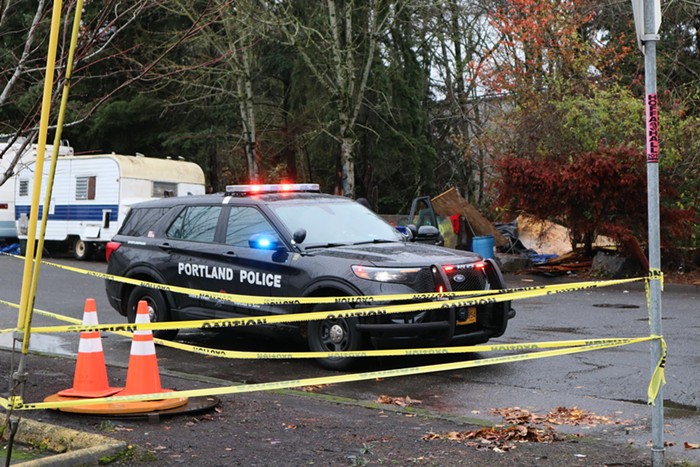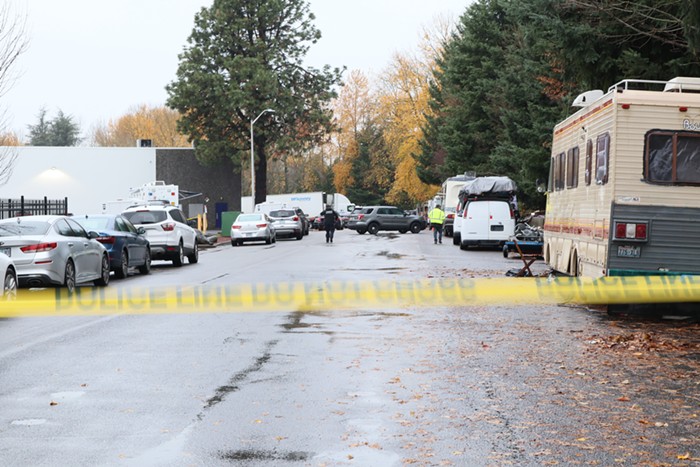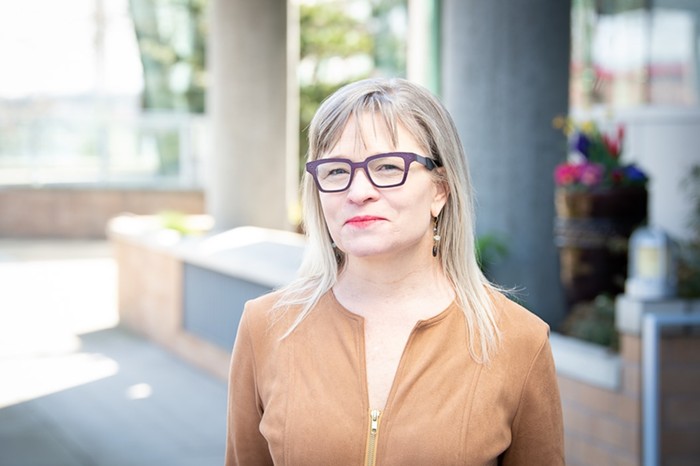Recently, however, I was standing down by the Willamette at Cathedral Park, staring off into space thinking about boys or shopping or nuclear attack, when I noticed one of those "Danger Sewage" signs. There was nothing pouring out of the pipe, but it prompted me to tilt my head to the side and think, "Hey where does all that shit go, anyway?"
After weeks of watching my poops swirl away into Neverland, and wondering where they ended up--and frankly, missing them a lot--I decided to quell my curiosity. I scheduled a tour of the Columbia Boulevard Wastewater Treatment plant. Knowledge is power (or at the very least a good poop story at the next kegger), and honestly, I wanted to see where the magic happens.
IT DOESN'T JUST GO AWAY
Running late and disorganized as usual, I asked for the person who was guiding my tour. "Yeah, I'm supposed to meet with Mike for a tour?"
There were all kinds of snacks on the front desk and it occurred to me that maybe they were placed there as a defensive measure. Like, even though the air is filled with the scent of poop, this is still a wonderful place to work, because there are snacks. I imagined that treatment plant workers might be like doctors: so callous to the sight of a dead body, or in this case, rivers of feces, they could even eat their lunch here. However, I didn't see anyone eating lunch.
After some confusion, Dan Clark (not Mike) met me in the business office at the plant. He was a normal-looking guy, maybe in his early 40s, wearing a button-up shirt. The kind of guy you'd guess was an electrician. He told me he'd worked at the plant for over 20 years. He's now the Public Works Superintendent and, despite all the layoffs, Dan is still around.
Dan and I walked through the entrance to the plant campus, which was a giant piece of pipe 11 feet in diameter. It looked like a giant doughnut. Dan explained that sewage (the mixture of poop and pee, rain water, sink water, shower water, washing machine water, etc.) reaches the plant via a huge concrete tunnel made out of pieces of pipe like this. It's then diverted into smaller channels to slow the chunky flow. Basically the sewage treatment process breaks apart the waste into its simplest components, removing more of "the bad" each step along the way.
Once the raging sewage river is slowed down, it enters a screen house where rocks, metal, sand, and gravel are sifted out. Afterwards, the sewage flow is raked for plastic, rags, Doritos bags, etc. Dan and I climbed some grated metal stairs to see the top of the rake. It's a 30-foot-tall, metal piece of machinery that looks like a giant comb. It emerges every minute or so from the ominous moat of raunch, dumping the trash over the top of the structure and into a dumpster. I couldn't help but think how much money it would take for me to lick that big rake.
Every day, 16 tons of this horribly rancid-smelling garbage is scraped out of the sewage and taken to the landfill. Leaving the building, Dan pointed to one of the empty dumpsters and said, "When those things aren't cleaned out, they can smell pretty foul." Truthfully, though, the dumpster was the most offensive smell I sniffed during the entire tour--other than that, the odor was never worse than standing over a sewage grate.
STAGE TWO
After the poop river is scraped for non-organics, it travels to sedimentation tanks for another breakdown. In the tanks, the water moves slowly so that solids sink to the bottom, and oil and grease float to the top. Grease is skimmed from the surface, and sludgy solids are scraped from the bottom and transferred to digestion tanks. The sedimentation tanks are indoors and covered because they contain some of the most nasty-smelling material. Besides, if they weren't covered, North Portland would really stink. During heavy rains, when there can be an increase from the usual 70 to 100 million gallons of sewage per day (enough to fill over 6,000 residential swimming pools) to up to 275 million gallons, backup outdoor sedimentation tanks are used.
LIKE FLIES ON SHIT
After emerging from the sedimentation tanks, the wastewater is a murky grayish brown, and still contains dissolved materials and suspended solids (also known as poop). It travels in channels beneath the plant sidewalks.
Walking over the grates that cover the channels is about as frightening as the time I was in Vancouver, B.C. and walked across a canyon on a suspension bridge. While there, I learned that some lady had recently tossed her baby into the river. Everyone was talking about it. It made the trip across to the other side that much more horrifying, and I kept thinking if I fell in the sewage, I'd want to be dead, too. Dan blithely walked over the precarious grates, chatting away, while I fearfully dodged around them. Call me chicken, but I'll be damned if I'm taking a bath in Portland's shit.
Once the flow has journeyed under the sidewalk from one side of the plant campus to the other, it's emptied into aeration tanks where it spends three hours. Here, a carefully controlled population of hungry microorganisms feed on the poop in the water. The sewage is in a long rectangular tank, and is a slightly smelly (in that rotten egg sort of way) grayish brown, bubbling from the oxygen pumped in for the bugs. According to Portland Environmental Services, "Nature would accomplish what's done in this part of the treatment process, but it would take seven to ten days and miles of flowing river. With the influx of millions of gallons of wastewater every day, the process needs to be enhanced and accelerated. The treatment plant does this job in hours."
After the solids have been chomped by the boo-boo bugs, the wastewater enters the final clarifiers, where it is again swept at the top and bottom (the microorganisms sink to the bottom) and sludge is returned to the previous tanks (for another chomping) or sent to the digesters. The water is in a giant circular open-air tank and flows slowly out over the edges of the tank for chlorine treating. It looks no worse than lake water.
Wastewater finally travels through an outfall where it's disinfected with chlorine, then pumped into the Columbia--about 50,000 gallons of treated water (or effluent) are pumped into the Columbia every minute. According to Environmental Services and plant personnel, the water only retains trace amounts of chlorine, and is not harmful to fish. And all of this works quite efficiently--unless, of course, it rains.
THE RAINY SEASON
Ironically enough, the biggest enemy of efficient sewage treatment in Puddletown is rain. Rain shoots up the amount of water that drains into the sewers, causing millions of gallons of extra liquid to mix with Portland's poop, and putting more strain on the treatment system.
During heavy rainstorms, sewage overflows occur, causing raw sewage (untreated poop and pee, rainwater etc.) to enter through outfall pipes the Willamette River and, to a lesser degree, the Columbia Slough. (The Slough is a 60-mile-long series of slow moving lakes, channels, and wetlands in the southern floodplain of the Columbia River.) According to Clean River Works, "Combined sewer overflows (CSOs) occur nearly every time it rains in Portland. During an [overflow] storm water quickly fills the combined sewers, which carry both sanitary sewage and runoff from the streets, parking lots, and rooftops. The overflows carry bacteria from the untreated sewage as well as other pollutants in the storm water." I wish I'd known that before I went tubing in the Willamette.
THE HISTORY OF PORTLAND'S POOP
The Center for Columbia River History notes that "in 1985, the Willamette/Slough system contained 56 pipes and concrete bunkers discharging raw sewage, industrial wastes, and toxic pollutants from city streets into the urban waterways. Despite complaints from citizens, in 1990, combined sewage overflows still poured billions of gallons of rainwater runoff and sewage annually into the Willamette River and Columbia Slough. Excessive bacteria endangered wildlife and humans, prompting environmentalists to place warning signs on the Slough."
In 1991, Northwest Environmental Advocates sued the City of Portland to end the discharge of raw sewage. Presently, sewage overflows to the Slough have been virtually eliminated because of system updates made by Environmental Services. While overflows to the Willamette River are still significant, improvements such as the West Side Big Pipe Project (bigger pipes carry more sewage, reducing overflows) will decrease overflows to the Willamette by 94 percent when the project is completed in 2011.
Regardless of these improvements, the combined sewage overflows, a long history of dumping, and municipal and industrial wastewater have loaded the Slough and lower Willamette with harmful heavy metals, dioxins and bacteria (not to mention condoms, syringes, and poop). This has made the temperature and chemical levels unsafe for wildlife. Fish swimming around in Portland's sewage have become unsafe for human consumption. In fact, the Columbia Watershed Council warns, "Eating Columbia Slough fish may be hazardous to your health. The fish contain PCBs and pesticides, as well as chemicals that may effect human development, reproduction, immune systems, and increase your chance of getting cancer." Yikes.
LIQUIDS AND SOLIDS
While the liquids that come from sewage are treated and released into the river, the solid matter has yet another life to live both at the treatment plant and beyond. The solids retrieved from the sewage separation process are pumped into huge water tower type tanks called digesters, which are oxygen-free tanks populated with other kinds of shit eating microorganisms called methane formers. Sludge stays in the digesters for two to four weeks, creating methane gas, which is used to power the treatment plant (our poop powers the plant that processes our poop? Whoa!), and sold to a nearby industry as a power source. Gas that isn't used (about 50%) is burned off and wasted. With the purchase of a new fuel cell, however, the plant will be able to convert more of the methane gas product into heat and energy that will be used not only within the plant, but eventually in nearby businesses and homes.
RECYCLING
The solids that are leftover after a few weeks in the digester are then squeezed of their remaining water. Dan Clark showed me this process, which involves many conveyer belts and rollers. Some of the water being squeezed from the now-digested poop squirted onto my shoes. Now I can't wear those shoes without thinking they stink.
And while it may not be pleasant to think about, the organic solids created from our poop have another valuable use: fertilizer. The city's digested feces, called biosolids, are used for what is called "land application," in which the nutrient-rich feces are used to enrich dry range land where beef cattle graze. Minerals and nutrients from biosolids are combined with the soil, increasing the amount of vegetation grown.
Kent Madison, an Eastern Oregon farmer, takes all of the biosolids from Portland, Washington County, and Salem--about 100-140 thousand tons yearly--for application on his 8,000-acre farm. With 65 percent of the state's biosolids as fertilizer, Madison uses the massive increase in vegetation to raise twelve times more cattle on the same amount of land.
FROM TOILET TO TAP
Unsurprisingly, biosolids, however valuable, come under frequent fire because of what Madison believes is negative public perception. Some debate that the inhalation of biosolids can make people sick, but it's never been proven. (See "Shit or Shinola?" below) The alternative to sucking poo-stench is clogging the landfills with millions of tons of useful organic material simply because it gives the public a major gross-out.
"It's a wonderful organic product," says Madison, "but the public sees it as what they flushed yesterday. But what you know from having toured the plant is that biosolids are actually the anaerobic bacteria that ate what you flushed yesterday. It's a great product."
When asked if he thought there was any risk in using the biosolids, Madison replied, "The risk associated with the use on non-agricultural land is with the public perception. It doesn't have anything to do with a natural risk or an environmental risk. A great example is if your article comes out negative against biosolids and blows a whole bunch of stuff out of proportion. Then the public thinks, 'I don't want to buy Kent Madison's beef because it's raised on biosolids.' That's why we only put the biosolids on dry range land, and not the land where we're raising the potatoes and carrots and peas--so it never touches our food crop. And we only do that because of public perception."
Madison has been using the biosolids program since 1990, and says he's never seen any ill effects in his cattle, or in his workers. "We've got four full-time employees who do nothing but the biosolids program, and they've been doing it for ten years now, and they're never sick."
While Madison considers biosolids to be a great product, there really isn't enough of it to supply very many farms; only one to two percent of commercial land is treated with biosolids.
In places with little water, municipal effluent (treated wastewater, just like the kind that flows into the Columbia) is used to water golf courses or highway interchanges--a seemingly fitting solution for a source of excessive water waste. As Madison says, "That's leaving the fresh water for you and I to drink, and it's taking the nutrients out of the reclaimed water, which the plants need anyway."
MYSTERY SOLVED
Back in the day, when I used to watch Mr. Rogers, I was always most fascinated by the video clip where they show orange crayons being manufactured. Liquid wax, molds, scraping, wrapping, collating... It was all news to me. As far as my poop goes, the process is well beyond what I imagined, but I'd probably rather not know that it might make its way to the Willamette, or out to a field to make food for my steak. But then again, instead of pondering the wonders of modern plumbing every time I see a poop swirl away to its not-so-mysterious destination, now I can think about more important things.
Like that impending nuclear attack.


















